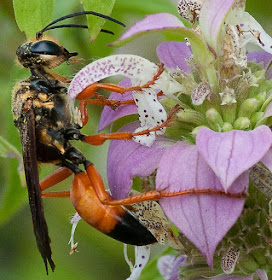
I found several of these large wasps on flowers in a warm season grass field. I couldn't get them to hold still for pictures and ended up netting this specimen. It is a Great Golden Digger Wasp, Sphex ichneumoneus, and both the wasp and its lifestyle are colorful.
 |
| Gathering nectar on a flower - Jon Sund |
The female digs a vertical burrow in the ground and create cells branching off at right angles. She then drags her paralyzed prey into a side cell and lays a single egg on it. The hatched larva will then feed on its cell mate.
 This pattern of stinging a victim and laying the egg on it is not uncommon among hymenoptera including mud daubers collecting spiders in their tubes and cicada killers burying their victims. What is unusual is its deeply ingrained ritual.
This pattern of stinging a victim and laying the egg on it is not uncommon among hymenoptera including mud daubers collecting spiders in their tubes and cicada killers burying their victims. What is unusual is its deeply ingrained ritual.When the female delivers her prey to the prepared burrow, she first goes down and inspects the chamber, then climbs out, grasps the antennae and pulls it down head first. If the prey is moved an inch or two away, it will drag it to the burrow, then crawl back down to inspect the burrow again before returning to haul it down. No matter how many times you move the prey, it repeats the inspection. This seems to be a genetically programmed behavior. The behavior of a highly trained entomologist sitting by a hole while repeatedly moving the prey is presumably a learned trait.
Another habit of the wasp described in Wikipedia is the antennae grip. If the antennae of the prey are removed, the wasp will not drag it down by a leg or other appendage but simply leave it on the ground. This may be a more practical adaptation as any other grip would mean trying to drag it sideways into a small hole.
I am always amazed that a small and delicate insect like this can dig a chambered tunnel though our Ozark clay and gravel soil that is a challenge for my shovel. Although not aggressive, the digger wasp will sting if picked up. It is a beneficial insect and I regret the loss of life in the name of science, but would have regretted it even more if it had stung me.
